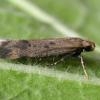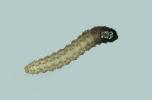35.032 Pexicopia malvella (Hübner, 1805)
Status and Distribution
Local, occasionally locally common in the south and east of England and apparently restricted to southern coastal areas in Wales. Believed absent from south-west England, Scotland and all of the island of Ireland. The few records from the midlands, northern England and Channel Islands are mostly very dated with the exception of a singleton found in Northumberland in 2019. Suggestions that the moth was found historically in VC81 (Berwickshire) have not been substantiated, while the single record from south Cumbria, although by an experienced recorder, would benefit from confirmation if possible.
There are indications of a contraction of range having occured in the early twentieth century in line with the decline of the main larval foodplant, marsh-mallow.

Provisional map
Foodplant and Larval Feeding Signs
Althaea officinalis (marsh-mallow), see plant distribution map, or cultivated Alcea rosea (hollyhock), occasionally Malva sylvestris (common mallow) and Malva moschata (musk-mallow).
In Europe, also found on Lavatera thuringiaca (garden tree-mallow), Malva alcea and Malva neglecta (dwarf mallow).
Feeds within the seedheads of the foodplant and later spins a cocoon in the larval workings where it overwinters. On Malva sylvestris, once found initially feeding entirely within the flowers and spinning a habitation therein before the seeds had formed at all.
Habitat
Finding the Moth
Larva: seeds of the foodplants collected during the late autumn and winter period may contain larvae.
Adult: readily attracted to light, both actinic and mercury-vapour.
Similar Species
Superficially similar to Platyedra subcinerea in size and shape. Pexicopia malvella has a generally darker fuscous colouring to the forewing, particularly obvious in the outer third and along the costa (leading edge) and lacks the black spot at the base of the wing. P. subcinerea has a prominent black spot at the base of the forewing near the dorsum (trailing edge) and a pale-ringed black spot at two thirds, most obvious on fresh specimens. There are differences in the flight period although overlap can occur in August and sometimes in early June.
Single brooded from June to mid-August, and rarely to early September.

















